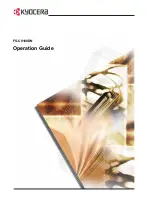
7
Chapter 7
Print Control Codes
102
In the case of (1):
•
This command is ended by a NULL code.
•
In the case of UPC-A and UPC-E, the bar code is printed at the point when 12
bytes of bar code data have been input, then data following next are processed as
ordinary data.
•
In the case of JAN13, the bar code is printed at the point when 13 bytes of bar code
data have been input, then data following next are processed as ordinary data.
•
In the case of JAN8, the bar code is printed at the point when 8 bytes of bar code
data have been input, then data following next are processed as ordinary data.
The number of data in an ITF bar code is always an even number. If the number of
data should happen to be odd, the final data are disregarded.
In the case of (2):
•
s indicates the number of data. Then from the next data, n bytes are processed as
bar code data.
•
If s deviates from the definition range, command processing is terminated and
processing of data from the next data is as for processing of ordinary data.
In the case of the Standard mode:
•
If D deviates from the definition range, a paper feed only is executed and process-
ing of data from the next data is as for processing of ordinary data.
•
If the horizontal width of a bar code exceeds the one line printing range, the bar
code is not printed, but a paper feed only is executed.
•
Paper feed by the amount of the bar code height (including HRI characters when
HRI characters are specified) is executed without relationship to the line feed amount
set by ESC 3, ESC 2, etc.
•
This command is disregarded when data exist in the print buffer.
•
When character code Dn is a character that cannot be printed, subsequent data are
treated as ordinary characters.
•
After printing of a bar code is completed, the head of the line is made the next print
position.
•
Except for inverted characters, the print mode (bold characters, double strike char-
acters, underline, character size) has no influence.
In the case of Page Mode:
•
Development of the bar code only is executed and printing is not done. When
development of the bar code is completed, the next dot after the last bar code data
is made the development start position for the next data.
•
If D deviates from the definition range, command processing is terminated and
processing of the next data is the same as for ordinary data.
•
At this time, the data development start position is not shifted.
•
If the horizontal width of a bar code exceeds the print area, the bar code is not
printed and the data development start position is moved to the left edge of the
place where it deviated from the print area.
Summary of Contents for CBM-262 Type II
Page 1: ...User sManual LINE THERMAL PRINTER CBM 262 MODEL ...
Page 41: ...6 31 Chapter 6 Interfaces Serial Interface Parallel Interface Drawer Kick Connector ...
Page 53: ...6 43 Drive Circuit 1 2 3 4 5 6 1 5A 24V Drawer Kick Connector ...
Page 54: ...6 Chapter 6 Interfaces 44 ...
Page 55: ...7 45 Chapter 7 Print Control Codes List of Control Codes Input Data Format ...
Page 116: ...7 Chapter 7 Print Control Codes 106 ...
Page 118: ...8 Chapter 8 Character Code Tables 108 Code Page ...
Page 119: ...8 109 Code Page ...
Page 120: ...8 Chapter 8 Character Code Tables 110 ...
Page 121: ...8 111 Japanese Code Table Japanese Code Table ...
Page 130: ...9 Chapter 9 Appendix 120 External View 12 359 162 ...
















































